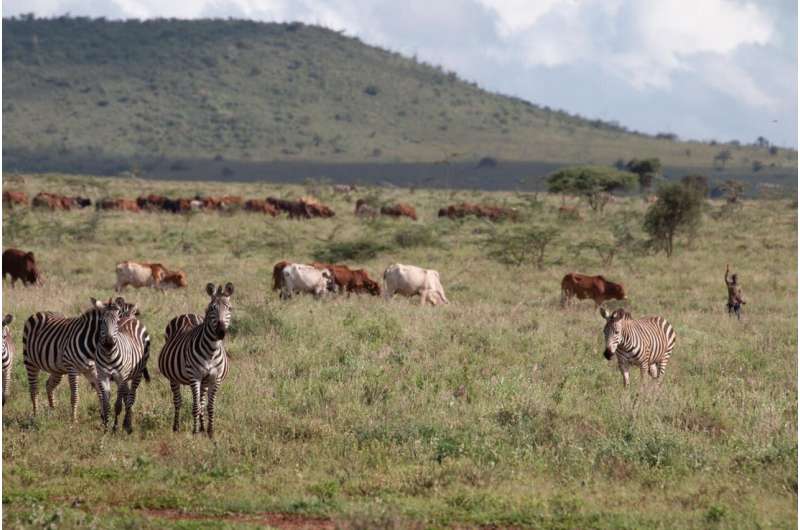New model for infectious disease could better predict future pandemics

In the midst of a devastating global pandemic of wildlife origin and with future spillovers imminent as humans continue to come into closer contact with wildlife, infectious-disease models that consider the full ecological and anthropological contexts of disease transmission are critical to the health of all life. Existing models are limited in their ability to predict disease emergence, since they rarely consider the dynamics of the hosts and ecosystems from which pandemics emerge.
Published May 17 in Nature Ecology and Evolution, Smithsonian scientists and partners provide a framework for a new approach to modeling infectious diseases. It adapts established methods developed to study the planet's natural systems, including climate change, ocean circulation and forest growth, and applies them to parasites and pathogens that cause disease.
Increased human-animal interactions lead to the emergence and spread of zoonotic pathogens, which cause about 75% of infectious diseases affecting human health. Predicting where, how and when people and animals are at risk from emerging pathogens—and the best ways to manage this—remains a significant challenge. Risks for spillover include, but are not limited to, habitat encroachment, illegal wildlife trade and bush meat consumption.
Despite incredible advances in the understanding of how infectious diseases are transmitted, the models these efforts are based on are relatively limited in scope, focusing on specific pathogens and often overlooking how pathogens interact within their hosts. While scientists and global health organizations are putting a lot of effort into studying the diversity of disease-causing organisms, existing models do not link this diversity to their roles within ecosystems.
"Just as a mechanic must understand how a car's components interact and how it's been engineered in order to improve performance, the same applies to our ability to model infectious disease," said first author Dr. James Hassell, wildlife veterinarian, epidemiologist and Keller Family Skorton Scholar for the Smithsonian Conservation Biology Institute's (SCBI) Global Health Program. "Applying systems-level thinking to forecast disease emergence requires a fundamental change in how we conceptualize infectious diseases. This presents significant challenges, but in this article, we explain why they're not insurmountable. When you weigh the cost of prevention versus remediation, the investment in our shared global health, particularly the connections between nature and human health, is vital."
Researchers say this new model will require expertise and collaboration across fields such as veterinary and human medicine, disease ecology, biodiversity conservation, biotechnology and anthropology.
"Disease and health are predominantly viewed as a human construct and the role the environment plays in disease is often overlooked," said Yvonne-Marie Linton, research director for the Walter Reed Biosystematics Unit for the Smithsonian's National Museum of Natural History and Walter Reed Army Institute of Research. "The health of other organisms, from parasites and insects to birds and aquatic organisms, can alter the structure of ecosystems. What we're proposing is a new approach to modeling infectious diseases that are circulating in nature, which would allow scientists to simulate the behavior of these pathogens in wildlife populations, how they respond to human activities and better determine the risk that they pose to people."
General ecosystem models are essentially complex models that can predict how food chains are assembled—the processes of energy transfer between plants and animals are what structure ecosystems—and determine the plants and animals that compose an ecosystem. With the new version, general "episystem" models, the paper's authors outline a framework for integrating disease agents (including parasites, viruses and bacteria) into these models. By identifying general rules for how food chains that include disease entities are structured, it should be possible to predict the types of pathogens that are present in any given ecosystem. This would allow scientists to better understand the characteristics of an ecosystem (such as disturbance) that would make it more likely to contain zoonotic pathogens, predict the threat it poses to people who interact with this ecosystem and even permit computer simulation and testing of interventions aimed at reducing these threats.
While the amount of data that would be required to create these models is daunting, long-term studies of intact ecosystems where parasite data has been collected are excellent places to initiate these studies. Efforts to refine them more broadly could then leverage large-scale ecological studies that span continents such as the Smithsonian's ForestGEO and MarineGEO programs.
The potential impacts of this new model go beyond reducing the human interface for disease spillover, to economics. "You could use this new approach to not only to look at human diseases, but also to look at the best way to conduct aquaculture or raise healthy livestock," said Katrina M. Pagenkopp Lohan, a marine disease ecologist at the Smithsonian Environmental Research Center. "If you're reintroducing a species into the wild, what do you need that ecosystem to look like for you to be successful? We could actually model that. It's mind blowing."
The cost of such a new approach is considerable, say researchers, and will take the global cooperation and commitment of scientists, communities, non-governmental organizations and nations. In an era of big data and massive advances in technology, this kind of approach is achievable but requires enhanced data collection, sharing and testing at far greater scales than currently occur.
More information: James M. Hassell et al, Towards an ecosystem model of infectious disease, Nature Ecology & Evolution (2021). DOI: 10.1038/s41559-021-01454-8
Journal information: Nature Ecology & Evolution
Provided by Smithsonian National Zoological Park



















